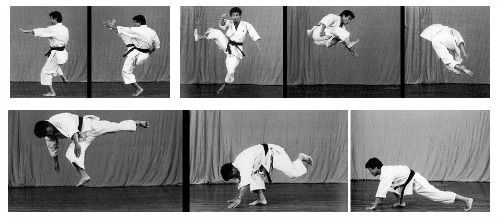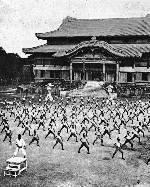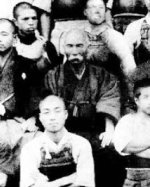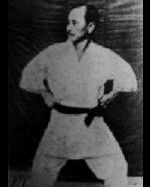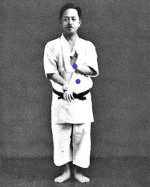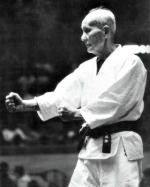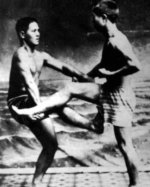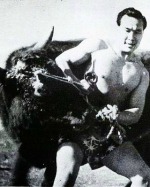The History of the Shotokan Kata – Part Two
Talk the Talk
When Gichin Funakoshi took karate to Japan in the 1920s with the intention of spreading the practice of the art, he changed much of the terminology (including many of the
names of the kata) from Okinawan words to Japanese.
He did this because many of the original words and names had Chinese origins and as there had been a long history of
animosity between China and Japan, he felt the new terminology would make karate more acceptable to the countrymen of his new adopted home.
While many of the new names introduced by Master Funakoshi took hold, some did not; the reason for this seems to be down to pure chance.
Walk the Walk
Seen by many as the very essence of karate, when practicing a kata one should always imagine using the moves to defend against a number of opponents or it becomes more akin to
a dance than an aid to learning self-defence.
When possible, applications of the techniques within the kata should also be practised with other karateka so that the execution
of the moves becomes automatic should they ever be needed.
Karate History Fact
As with many aspects of studying the past, distinguishing between karate kata historical fact and martial arts legend is very difficult.
This is because unfortunately, the old Okinawan karate masters who handed down many of the early versions of these forms did not keep written records as the art was illegal and
therefore practised in secret.
Even well into the twentieth century, we often have to rely on oral history or documentation that used oral history as its sources, meaning that
much of the information we have on the Shotokan kata history is hotly debated or largely speculation.
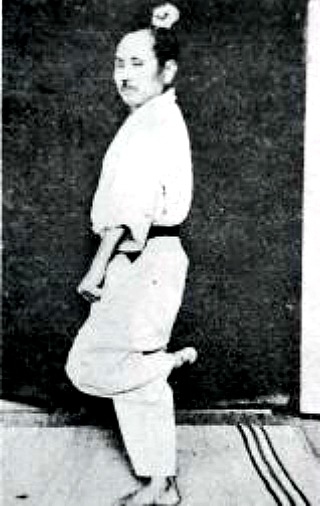
Kata is an integral part of karate history and is a training exercise used to improve many aspects of the martial art including technique, speed, timing and control over one’s body, as well as being a great aid to strengthening all the major muscle groups. They range from basic and intermediate kata designed to aid the karateka’s transition from beginner to black belt, to the more advanced kata listed here, which can often challenge even the most dedicated and experienced karateka.
The History of Wankan
The kata Wankan (Kings Crown) is also known as Ohkan (which means the same thing in Japanese) and has a particularly clouded history. The name is believed by some to be taken from the first three moves of the kata which can be said to resemble a crown when viewed head-on, with the first two moves forming the two side diadems and the third move creating the centrepiece of the crown.
However, many karate scholars argue that this is just a coincidence as Okinawan kings did not wear metal crowns like the ones worn by the monarchs of Europe. Some karate styles practice a kata with the same name but completely different moves to the one in Shotokan which may suggest both are only a portion of a longer, lost original kata. Wankan, along with Ji’in, was left out of Masatoshi Nakayama’s definitive kata series Best Karate though is still taught by many Shotokan masters around the world.
The History of Gankaku
Gankaku (Crane on a Rock) is a very old kata that was previously named Chinto (Fighter/Battle to the East). According to martial arts legend, it was introduced to Okinawa by a nineteenth-century Chinese sailor of the same name (though he is sometimes known as Annan) who was washed ashore off the coast after a shipwreck. To survive, Chinto stole local crops which provoked complaints to the king who promptly sent his bodyguard, Okinawan karate Master Sokon Matsumura, to defeat the foreigner.
Matsumura was an early karateka from the Shuri-te style and was considered by many to be the best martial artist of his day in Okinawa but when he fought against Chinto, the two were evenly matched and the ensuing fight was drawn. After this, they became friends and the kata Chinto and other techniques and forms from Chinese kung fu were introduced to the island. The name was later changed by Gichin Funakoshi but while he changed many names to make them more acceptable to the Japanese, in the case of Gankaku the name change was extra important as he wanted to remove the connotations of war suggested in the name Chinto.
The History of Meikyo
Meikyo (Bright/Polished Mirror) was renamed by Master Funakoshi from its original name Rohai (Vision of a Crane) though many people in Shotokan and other styles still use the old name. The kata comes from the Tomari-te school where it was originally a set of three kata, Rohai Shodan, Rohai Nidan, and Rohai Sandan.
These were probably adapted by Sensei Anko Itosu who derived the moves from a much longer version of Rohai which was possibly invented by Kosaku Matsumora, suggested by the fact that it was known as Matsumora Rohai. While all three of Itosu’s Rohai kata set are still taught in some styles of karate, Meikyo is the only one on the Shotokan syllabus. However, it differs from other versions of the Rohai kata so it is believed to have been put together as a combination of all three, but when and by whom is unknown.
The History of Chinte
Chinte (Strange Hands) is one of a number of kata that Gichin Funakoshi unsuccessfully attempted to rename (to Shoin). It is thought to be one of the earlier kata in karate history and probably has its origins in China, though it has also been suggested that it is actually derived from an Okinawan folk dance. If this is true, some suggest that the dance symbolizes all the things a woman should know about life according to the culture of the time including child rearing and being subservient to her husband.
This is backed up by the fact that it is a form that seems to favour female karateka as the unusual style targets vulnerable areas such as the eyes where much less brute force is needed to be effective. However, unlike most Shotokan kata, it consists of predominantly circular movements instead of the more common linear ones which may suggest it comes from a kung fu ancestry.
The final three movements of Chinte are a series of three backward hops, apparently unique within world martial arts. What they represent is debated but they may have been introduced to get the karateka back to his or her starting/finishing mark for competition purposes as they are absent in versions of the kata practised outside of Shotokan. However, it could also be the case that they were in fact dropped by other styles precisely because interpretation of them is so problematic.
The History of the Gojushiho Kata
Gojushiho (Fifty-Four Steps) is a set of two kata (Sho/Minor and Dai/Major) that are believed to have been created by Sokon ‘Bushi’ Matsumura for the Tomari-te system and are thought to have been both his best and final contribution to karate kata history. Master Funakoshi attempted to rename the Gojushiho kata Hotaku (Woodpecker) but this was another instance where the name did not stick.
In Shotokan, at some point Gojushiho Sho became Gojushiho Dai and vice-versa though exactly when and why is unknown. According to karate legend, sometime in the 1960s or 70s at the All Japan Karate Championships, a high-ranking karateka of the Japanese Karate Association announced Gojushiho Dai then did the wrong kata. Because he was so revered, nobody dared tell him so most Shotokan karateka started reversing the name, though some, like Hirokazu Kanazawa, continued to keep them in the original order.
However, this story is unlikely to be true as whoever the mystery competitor was, at least some of his opponents would have been just as highly ranked. Therefore, they would have expected to be treated fairly in such a major competition, so would not have stood for such a blatant disregard for competition rules meaning the reason for the switch in names remains a mystery.
The History of Sochin
Sochin (Tranquil Force/Strong Calm/Immovable) is believed to be particularly good for developing the internal energy known as Ki (Chi in Chinese). It may have its origins in Dragon Style kung fu, later coming through the Naha-te school in Okinawa where it was taught by the nineteenth-century Okinawan karate master Seisho Arakaki. It is thought that it was then passed down to Higaonna Kanryo, another famous teacher from the Naha-te school, who in turn taught the kata to Kenwa Mabuni, the founder of Shito-Ryu karate.
Gichin Funakoshi’s son Yoshitaka, an innovator in the development of Shotokan karate in his own right, spent some time learning kata from Mabuni’s son, Kenzo and as a result, the Shotokan syllabus gained not only Sochin, but also Nijushiho and Unsu. In his book, Karate Kata Zenshu, Hirokazu Kanazawa claims that Sochin gets its name from the extensive use of the stance sochin dachi. However, it has been suggested that the stance, originally called Fudo, was renamed Sochin at some point in reference to the kata.
The latter seems more likely as it is thought that after learning Sochin, Yoshitaka made several changes in the late 1930s which probably included the heavy usage of sochin dachi, a stance he is known to have heavily favoured. This was another kata that kept its old name despite Master Funakoshi attempting to rename it Hakko, a change that was possibly unsuccessful as a result of the connection between the kata and the stance.
The History of Nijushiho
Nijushiho (Twenty-Four Steps) was previously known by the Okinawan name Niseishi (which also means Twenty-Four Steps) but was changed by Sensei Gichin Funakoshi very early in Shotokan kata history. The origins of the kata are unknown though some scholars believe that like Sochin, it originally comes from the Chinese Dragon Style of fighting.
Others believe the kata was created by Seisho Arakaki, though the prevalent theory is that he learned and developed it rather than being its original source. Arakaki taught Niseishi to Higaonna Kanryo, who passed the knowledge on to Kenwa Mabuni. He taught it to his son Kenzo who in turn taught it to Yoshitaka Funakoshi, son of Gichin.
The History of Unsu
Unsu (Hands in the Clouds) is considered by many as the most difficult of all the Shotokan kata and according to Sensei Masatoshi Nakayama, anyone trying to master Unsu before first mastering the Heian kata, Kanku-Dai, Empi and Jion will look like, “a scarecrow trying to dance." Like Sochin and Nijushiho, it is thought to come from the Dragon Style of kung fu and then later through the Naha-te school of Okinawan karate, though its exact origins are unknown.
Interestingly, some believe that Unsu is a kata steeped in symbolism with the moves representing a thunderstorm. The first move, so the theory goes, represents a squall line on the horizon and in the next sequence of techniques the circles on the ground drawn by the feet along with the finger strikes represents dust devils gathering as lightning strikes the ground.
The next combinations involving rapid strikes in all directions can be seen as symbolic of winds blowing in all directions and the jumping, spinning back-kick towards the end of Unsu, one of the hardest moves to master in any Shotokan kata, can be seen as a powerful tornado. Generally speaking, the slow movements that are followed by explosive ones throughout the kata can be seen as a calm in the storm before it ferociously blows up again destroying anything that gets in its path.
See Also - The History of the Shotokan Kata – Part One
Written by Andrew Griffiths – Last updated 21/09/2023. If you like
what you see, consider following the History of Fighting on social media.
Find Us On:



Further Reading:
Nakayama, M. 1981. Best Karate, Volume 7. Kodansha International. Japan.
Shotokan Kata. [Internet]. 2013. The Shotokan Way. Available From: http://www.theshotokanway.com/shotokankata.html [Accessed January 20 2018].
Shotokan Kata. [Internet]. 2013. UNH Shotokan Karate Club. Available From: http://unh.edu/karate [Accessed January 20 2018].
More Karate History
Karate History Home
The history of karate begins in Okinawa, where martial arts were influenced by both kung fu from China, and the Japanese samurai. After weapons were banned on the island, unarmed combat techniques were developed into a style of fighting recognisable as traditional karate, which was further developed after being taken to Japan in the early twentieth century by Gichin Funakoshi.
The history of karate begins in Okinawa, where martial arts were influenced by both kung fu from China, and the Japanese samurai. After weapons were banned on the island, unarmed combat techniques were developed into a style of fighting recognisable as traditional karate, which was further developed after being taken to Japan in the early twentieth century by Gichin Funakoshi.
The History of Okinawan Karate
A look at the history of Okinawan karate and how it developed from the seventeenth century. Okinawan martial arts had influences from both the Japanese samurai and Chinese kung fu, as well as techniques unique to the island itself which over the years blended and evolved into the traditional karate styles that are practiced all over the world today.
A look at the history of Okinawan karate and how it developed from the seventeenth century. Okinawan martial arts had influences from both the Japanese samurai and Chinese kung fu, as well as techniques unique to the island itself which over the years blended and evolved into the traditional karate styles that are practiced all over the world today.
The Life and Legends of Anko Itosu
Anko Itosu was a legendary Okinawan martial artist and a pioneer in the development of karate history. He popularised many aspects of the fighting system through his Shuri-te style and helped increase the number of people who were permitted to learn it by bringing karate training out of secrecy, and even gained permission to teach it in Okinawan schools.
Anko Itosu was a legendary Okinawan martial artist and a pioneer in the development of karate history. He popularised many aspects of the fighting system through his Shuri-te style and helped increase the number of people who were permitted to learn it by bringing karate training out of secrecy, and even gained permission to teach it in Okinawan schools.
Gichin Funakoshi - Father of
Modern Day Karate
Gichin Funakoshi was born in Okinawa in 1868 and is known as the father of modern-day karate due to the innovations he made to Okinawan martial arts when he took it to Japan and popularised it with the people there. Not only did he found Shotokan karate, but he was also instrumental in spreading karate across the world.
Gichin Funakoshi was born in Okinawa in 1868 and is known as the father of modern-day karate due to the innovations he made to Okinawan martial arts when he took it to Japan and popularised it with the people there. Not only did he found Shotokan karate, but he was also instrumental in spreading karate across the world.
The History of the Shotokan Kata – Part One
A look at the history of the more basic Shotokan kata, including their origins, development, interesting facts and scholastic debate. This list of kata histories includes, Kihon kata, the Heian kata, the Tekki group, Bassai Dai and Sho, Empi, Hangetsu, Kanku Sho and Dai, Jion, Ji’in and Jitte and includes video links to the relevant kata.
A look at the history of the more basic Shotokan kata, including their origins, development, interesting facts and scholastic debate. This list of kata histories includes, Kihon kata, the Heian kata, the Tekki group, Bassai Dai and Sho, Empi, Hangetsu, Kanku Sho and Dai, Jion, Ji’in and Jitte and includes video links to the relevant kata.
Kenwa Mabuni – Founder of Shito-Ryu Karate
Kenwa Mabuni started life as a sickly child but transformed himself into a strong warrior through the practice and dedication to the martial arts. Through his studies with
great karate masters such as Anko Itosu and Kanryo Higaonna, along with the kung fu master Woo Yin Gue, he was able to combine what he had learned and develop one of the four
major styles of traditional karate, Shito-Ryu.
Hironori Otsuka – Founder of Wado-Ryu Karate
Hironori Otsuka was a renowned master of jujitsu by the age of 28 before becoming a karate student under Gichin Funakoshi. He excelled and quickly rose through the ranks to become an assistant instructor, helping to develop training techniques in Shotokan karate. Later, Master Otsuka would brake away and form Wado-Ryu, one of the main four styles of traditional karate.
Hironori Otsuka was a renowned master of jujitsu by the age of 28 before becoming a karate student under Gichin Funakoshi. He excelled and quickly rose through the ranks to become an assistant instructor, helping to develop training techniques in Shotokan karate. Later, Master Otsuka would brake away and form Wado-Ryu, one of the main four styles of traditional karate.
The Real Mr Miyagi – Founder of Goju Ryu
Sensei Chojun Miyagi was an early karate master who studied martial arts in both China and his homeland, Okinawa. He earned his place in martial arts history when he used his knowledge to blend soft (or internal) with hard (or external) techniques to develop the style known as Goju-Ryu, which is considered one of the main four styles and is today widely practiced throughout the world techniques.
Sensei Chojun Miyagi was an early karate master who studied martial arts in both China and his homeland, Okinawa. He earned his place in martial arts history when he used his knowledge to blend soft (or internal) with hard (or external) techniques to develop the style known as Goju-Ryu, which is considered one of the main four styles and is today widely practiced throughout the world techniques.
Mas Oyama – Founder of Kyokushin Karate
Mas Oyama, founder of Kyokushin karate was one of the best karate masters of all time. He developed his body, mind and techniques through rigorous training and fought and won hundreds of full contact battles against fighters from many different martial arts styles. To test his skills further, he also went head to head with 52 bulls and was victorious in all, whether against man or beast.
Mas Oyama, founder of Kyokushin karate was one of the best karate masters of all time. He developed his body, mind and techniques through rigorous training and fought and won hundreds of full contact battles against fighters from many different martial arts styles. To test his skills further, he also went head to head with 52 bulls and was victorious in all, whether against man or beast.
The images on this site are believed to be in the public domain, however, if any mistakes have been made and your copyright or intellectual rights have been breeched, please contact andrew@articlesonhistory.com.

